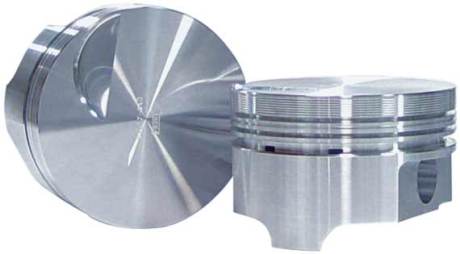There are disadvantages also, of course. The piston will be weaker in structure. It is often heavier since the manufacturer has to increase wall thickness in order to achieve sufficient strength. The heat expansion cannot be controlled and is therefore often not completely round since the piston pin requires some material on the inside. They are also produced in bulk with most manufacturers only producing sizes that are close to factory specifications. This also makes them more affordable.
Although internal combustion engine pistons commonly contain trace amounts (less than 2% each) of copper, manganese, and nickel, the major element in automotive pistons is aluminum due to its light weight, low cost, and acceptable strength. The alloying element of concern in automotive pistons is silicon.
Silicon in this context can be thought of as “powdered sand”. Any silicon that is added to aluminum above a 12% content will retain a distinct granular form instead of melting. At a blend of 25% silicon there is a significant reduction of strength in the piston alloy so stock hypereutectic pistons commonly use a level of silicon between 16% and 19%. Special molds, casting, and cooling techniques are required to obtain uniformly dispersed silicon particles throughout the piston material.
The biggest drawback of adding silicon to pistons is that the piston becomes more brittle as the ratio of silicon is added. This makes the piston more susceptible to cracking if the engine experiences pre-ignition or detonation as well as when power adders are installed. Performance replacement alloys.
When auto enthusiasts want to increase the power of the engine they may add some type of forced induction. By compressing more air and fuel into each intake cycle, the power of the engine can be dramatically increased. This also increases the heat and pressure in the cylinder.
The 4032 performance piston alloy has a silicon content of approximately 11%. This means that it expands less than a piston with no silicon, but since the silicon is fully alloyed on a molecular level (eutectic), the alloy is less brittle and more flexible than a stock hypereutectic “smog” piston. These pistons can survive mild detonation with less damage than stock pistons.
Aftermarket performance pistons are most commonly made from 4032 and 2618 alloys and are typically forged. The 2618 performance piston alloy has less than 2% silicon. This alloy is capable of experiencing the most detonation and abuse while suffering the least amount of damage.
By utilizing state-of-the-art CNC machines, most manufacturers can maintain exact specifications and tolerances. This makes them structurally more durable. Forged pistons are well known in the racing and performance industry because of their ability to withstand more heat, higher RPMs, higher boost and higher temperatures. But forged pistons are not just for professional racers. Another advantage to a forged piston is that they can be individually made to any custom size or specification without the high cost of casting.
The choice between using a Cast, Hypereutectic or Forged piston is dictated by the application. Forged pistons may not be absolutely necessary in all applications. However, the minor additional cost of a forged piston can save your motor from disaster in a marginal situation.

